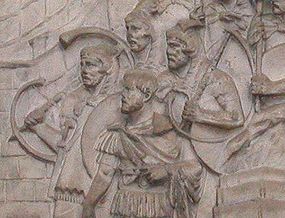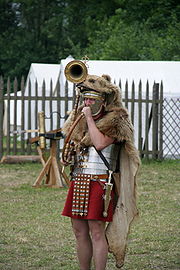
Cornu (horn)
Encyclopedia


Buccina
A buccina or bucina , anglicized buccin or bucine, is a brass instrument used in the ancient Roman army similar to the Cornu. An aeneator who blew a buccina was called a "buccinator" or "bucinator" ....
used by the Roman army
Roman army
The Roman army is the generic term for the terrestrial armed forces deployed by the kingdom of Rome , the Roman Republic , the Roman Empire and its successor, the Byzantine empire...
of antiquity mainly for communicating orders to troops in battle. It is a Latin
Latin
Latin is an Italic language originally spoken in Latium and Ancient Rome. It, along with most European languages, is a descendant of the ancient Proto-Indo-European language. Although it is considered a dead language, a number of scholars and members of the Christian clergy speak it fluently, and...
word literally meaning horn
Horn (anatomy)
A horn is a pointed projection of the skin on the head of various animals, consisting of a covering of horn surrounding a core of living bone. True horns are found mainly among the ruminant artiodactyls, in the families Antilocapridae and Bovidae...
. The instrument was about 3 m (9.8 ft) long and took the form of a letter 'G'. The instrument was braced by a crossbar that stiffened the structure and provided a means of supporting the instrument's weight on the player's shoulder. Two specimens survive from the ruins of Pompeii
Pompeii
The city of Pompeii is a partially buried Roman town-city near modern Naples in the Italian region of Campania, in the territory of the comune of Pompei. Along with Herculaneum, Pompeii was destroyed and completely buried during a long catastrophic eruption of the volcano Mount Vesuvius spanning...
.
The cornu was carried by the cornicen
Cornicen
A cornicen was a junior officer in the Roman Army. The cornicen's job was to signal salutes to officers and sound orders to the legions. The cornicines played the cornu . Cornicines always marched at the head of the centuries, with the tesserary and the signifer...
(horn-blower) who coded the general's orders into signals and broadcast them over the field during battles. The cornicen's horn curved around his body. The Roman army also made use of a straight trumpet called a tuba
Roman tuba
The tuba of ancient Rome is a military signal trumpet, quite different from the modern tuba. The tuba was produced around 500 BC. Its shape was straight, in contrast to the military buccina or cornu, which was more like the modern tuba in curving around the body. Its origin is thought to be...
(different from the modern tuba
Tuba
The tuba is the largest and lowest-pitched brass instrument. Sound is produced by vibrating or "buzzing" the lips into a large cupped mouthpiece. It is one of the most recent additions to the modern symphony orchestra, first appearing in the mid-19th century, when it largely replaced the...
).
The late Roman
Ancient Rome
Ancient Rome was a thriving civilization that grew on the Italian Peninsula as early as the 8th century BC. Located along the Mediterranean Sea and centered on the city of Rome, it expanded to one of the largest empires in the ancient world....
writer Vegetius
Vegetius
Publius Flavius Vegetius Renatus, commonly referred to simply as Vegetius, was a writer of the Later Roman Empire. Nothing is known of his life or station beyond what he tells us in his two surviving works: Epitoma rei militaris , and the lesser-known Digesta Artis Mulomedicinae, a guide to...
, in his work De Re Militari
De Re Militari
De Re Militari , also Epitoma Rei Militaris, is a treatise by the late Latin writer Vegetius about Roman warfare and military principles as a presentation of methods and practices in use during the height of Rome's power, and responsible for that power...
, wrote:
- The music of the legion consists of trumpets, cornets and buccinaBuccinaA buccina or bucina , anglicized buccin or bucine, is a brass instrument used in the ancient Roman army similar to the Cornu. An aeneator who blew a buccina was called a "buccinator" or "bucinator" ....
e. The trumpet sounds the charge and the retreat. The cornets are used only to regulate the motions of the colors; the trumpets serve when the soldiers are ordered out to any work without the colors; but in time of action, the trumpets and cornets sound together. The classicum, which is a particular sound of the buccina or horn, is appropriated to the commander-in-chief and is used in the presence of the general, or at the execution of a soldier, as a mark of its being done by his authority. The ordinary guards and outposts are always mounted and relieved by the sound of trumpet, which also directs the motions of the soldiers on working parties and on field days. The cornets sound whenever the colors are to be struck or planted. These rules must be punctually observed in all exercises and reviews so that the soldiers may be ready to obey them in action without hesitation according to the general's orders either to charge or halt, to pursue the enemy or to retire. For reason will convince us that what is necessary to be performed in the heat of action should constantly be practiced in the leisure of peace.
The cornu was revived as the "tuba curva" during the French Revolution
French Revolution
The French Revolution , sometimes distinguished as the 'Great French Revolution' , was a period of radical social and political upheaval in France and Europe. The absolute monarchy that had ruled France for centuries collapsed in three years...
. The tuba curva was first used in music that André Grétry composed for the funeral of Voltaire
Voltaire
François-Marie Arouet , better known by the pen name Voltaire , was a French Enlightenment writer, historian and philosopher famous for his wit and for his advocacy of civil liberties, including freedom of religion, free trade and separation of church and state...
.

